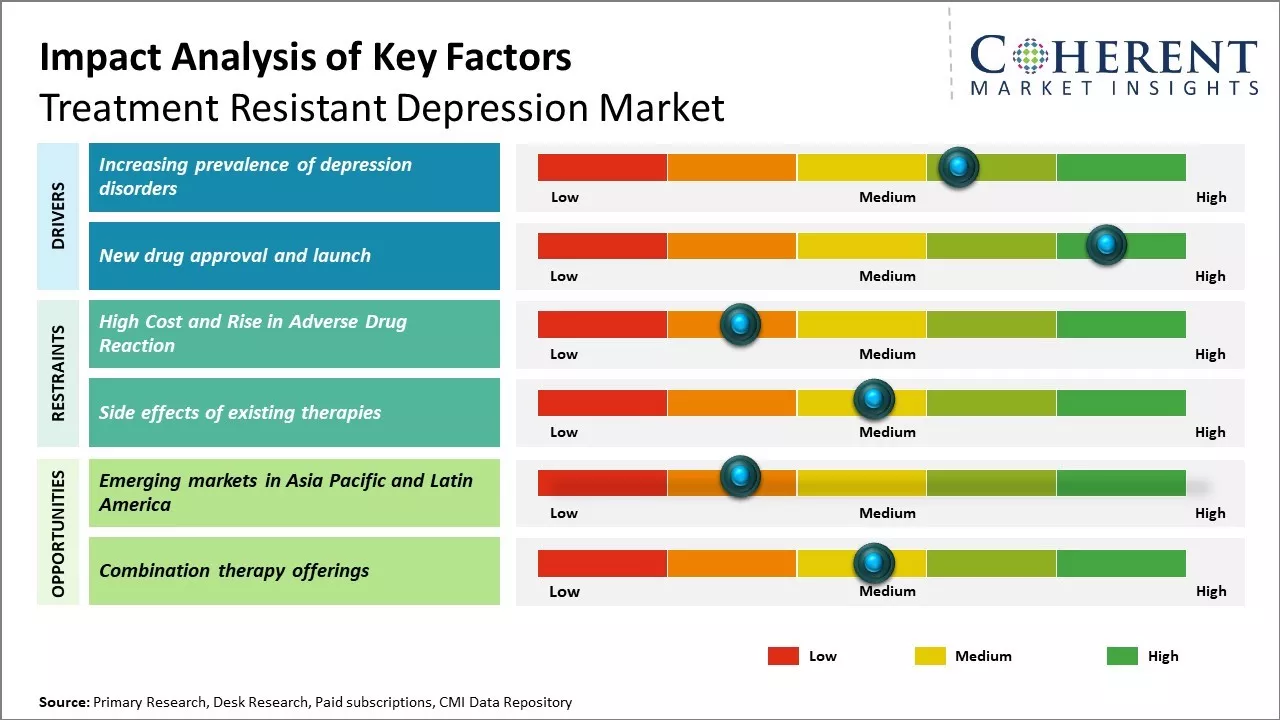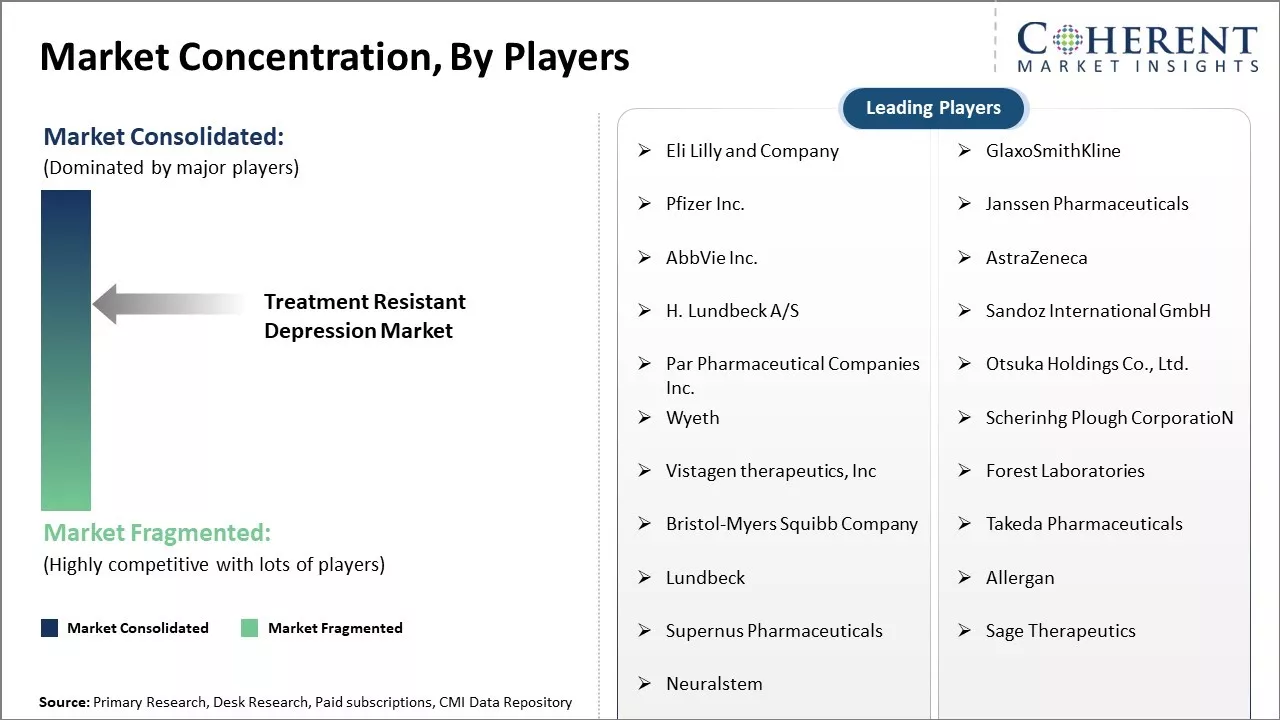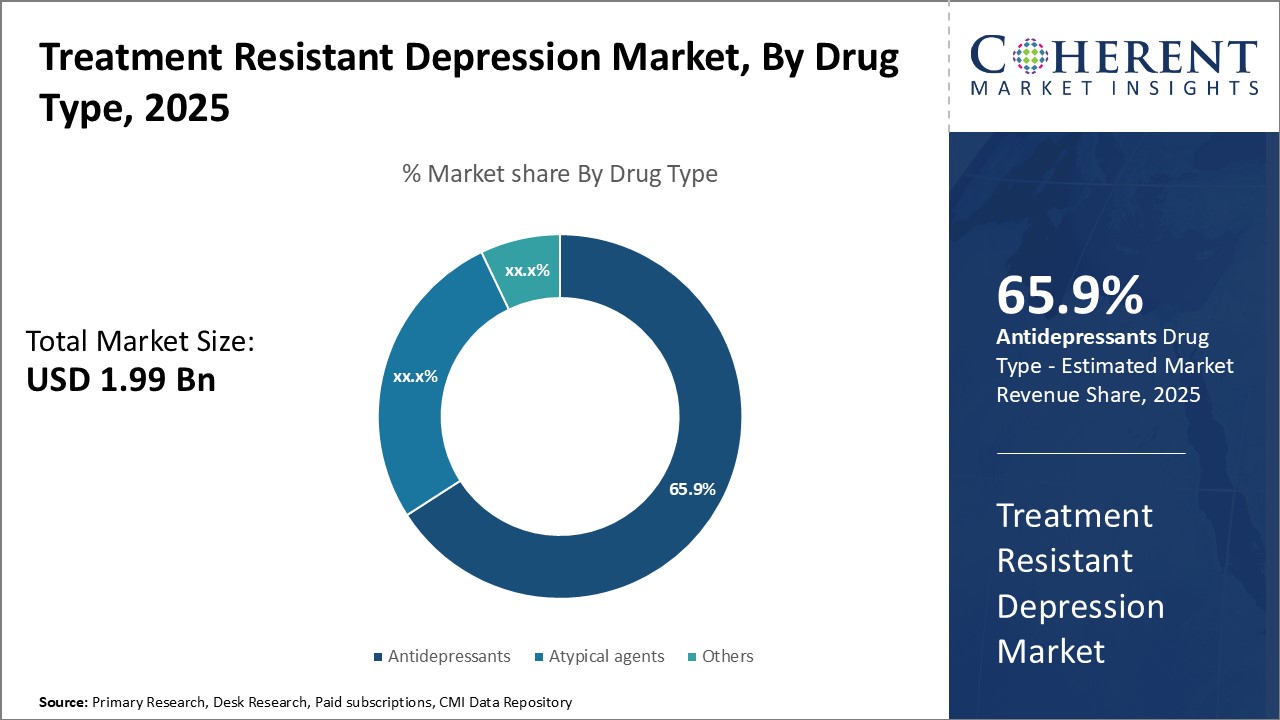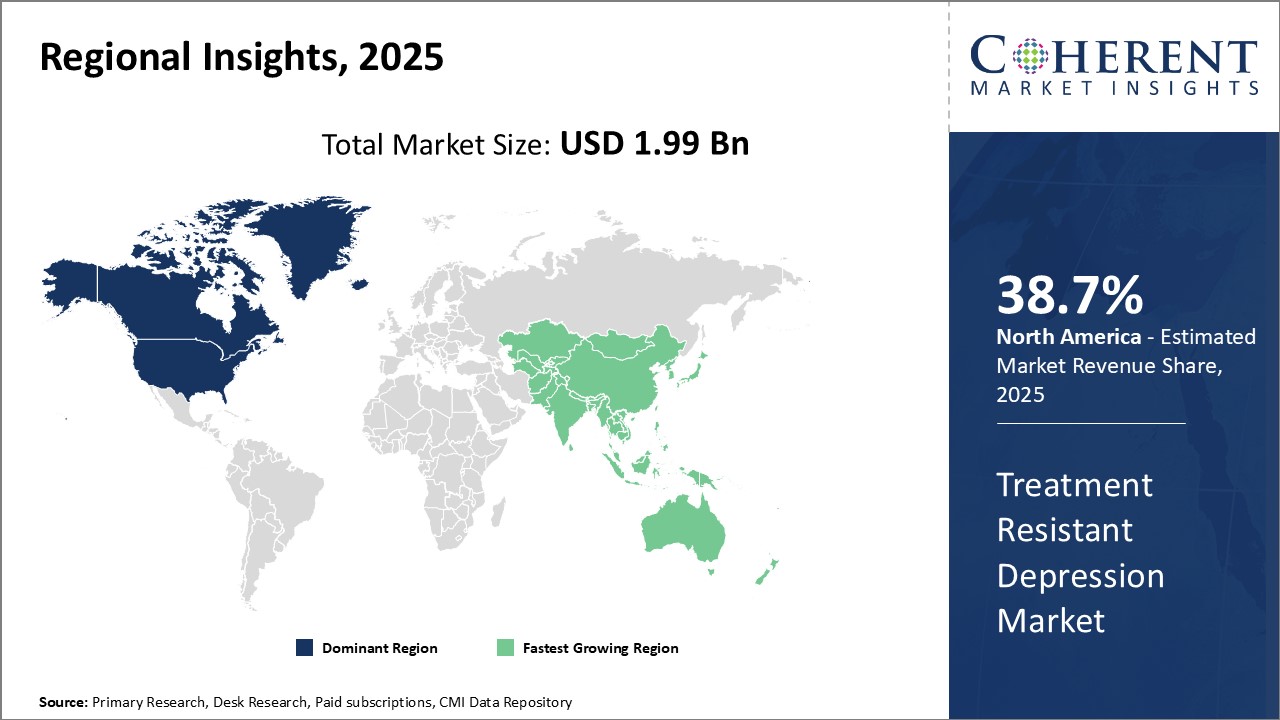The Treatment Resistant Depression Market is estimated to be valued at USD 1.99 billion in 2025 and is expected to reach USD 2.70 billion by 2032, exhibiting a compound annual growth rate (CAGR) of 4.5% from 2025 to 2032.

Discover market dynamics shaping the industry: Download Free Sample
Rising cases of treatment resistant depression, growing awareness regarding available treatment options, and increasing access to healthcare facilities are expected to aid the market growth during the forecast period. However, high costs associated with R&D activities for developing novel molecules and therapies along with risks associated with clinical trials may hinder the market growth to some extent. Overall, the increasing uptake of combination therapies and presence of strong product pipeline are expected to offer new opportunities for players operating in this market in the coming years.
Increasing prevalence of depression disorders
The global treatment resistant depression market is anticipated to experience growth during the forecast period, propelled by factors such as the increasing prevalence of depression. For example, data from the National Institute of Mental Health in January 2022 revealed that approximately 21.0 million adults in the U.S. experienced at least one major depressive episode in 2020, equating to 8.4% of the total adult population. Additionally, heightened awareness about depression and the introduction of new medications are contributing to the market expansion. According to the World Health Organization (WHO) as of June 2021, over 700,000 individuals die by suicide annually, making it the fourth leading cause of death among 15-19-year-olds. Moreover, countries with fast-paced economies like the U.K. and the U.S. exhibit a significant proportion of their populations affected by depression. For instance, in June 2022, according to Anxiety and Depression Foundation statistics updated, generalized anxiety disorder is expected to impact 6.8 million adults annually, constituting 3.1% of the U.S. population. Therefore, the increasing global incidence of depression is forecast to drive the market growth in the coming years.

Get actionable strategies to beat competition: Download Free Sample
New drug approval and launch
Key players in the market are actively pursuing approvals for their innovative drugs designed to treat treatment resistant depression and subsequently launching them in the market. These efforts are anticipated to significantly contribute to market growth in the coming years. For instance, Denovo Biopharma LLC, a clinical-stage biopharmaceutical company specializing in biomarker-driven precision medicines, received authorization from the U.S. Food and Drug Administration (FDA) in January 2022 for its investigational new drug (IND) application of DB104 (liafensine) for treatment resistant depression (TRD). This milestone allows Denovo to initiate a global Phase 2b clinical trial to evaluate the safety and effectiveness of liafensine in TRD patients.
Key Takeaways of Analyst:
One of the major drivers contributing to the treatment resistant depression market growth is the increasing cases of patients not responding to first-line antidepressant drugs. Many patients struggle with depression for longer durations without getting complete relief from existing treatment options. This non-responsiveness has led to an increase in demand for alternative treatment choices.
However, high cost of newer treatment modalities is one of the major challenges as these therapies demand longer duration of treatment and follow ups. Also, lack of awareness about newer treatment options in developing regions may limit growth opportunities in the near term. The U.S. represents the largest regional market currently due to the availability of advanced treatment choices and supportive reimbursement structure. Within the U.S., specialty clinics adopting newer therapies are expected to boost market revenues. Europe is also expanding steadily driven by rising research into novel drugs and devices.
Approval and uptake of new drug classes like Ketamine can provide significant growth prospects over the next five years. Adjunct non-pharmacological therapies including Electroconvulsive Therapy and Neurostimulation devices are also gaining traction. If successful, these new-age therapies may capture higher market share by addressing the unmet needs of hard-to-treat patients.
Market Challenges: High Cost and Rise in Adverse Drug Reaction
The high cost of drugs used to treat treatment resistant depression is anticipated to hinder market growth in the forecast period. For example, in March 2020, Johnson & Johnson, a multinational pharmaceutical and biotechnology company, announced the pricing of its nasal spray depression treatment, Spravato, at US$ 590 for a 56 mg dose and US$ 885 for an 84 mg dose, which may pose financial challenges for patients seeking this medication. The high cost of drugs used to treat treatment resistant depression is significantly restraining the growth of Treatment Resistant Depression Market. Treatment resistant depression refers to a condition where individuals do not respond to at least two antidepressant treatments of adequate dose and duration in the current depressive episode. While the exact prevalence is unknown, it is estimated that nearly 30–50% of individuals with major depressive disorder have treatment resistant depression.
Market Opportunities: Promising Opportunities in Treatment resistant Depression
The current drug pipeline is promising and includes new molecular entities targeting neurotransmitter pathways beyond serotonin and norepinephrine. Advances in digital and remote healthcare technologies allow for more precise diagnosis and combination with non-drug therapies. Growing mental health awareness has increased screening and diagnosis rates, highlighting the need for more effective solutions. An improved understanding of depression.

Discover high revenue pocket segments and roadmap to it: Download Free Sample
Insights, By Drug Type: Antidepressants Lead Treatment resistant Depression Market Due to Efficacy and Affordability
In terms of By Drug Type, Antidepressants dominate the treatment resistant depression market, constituting the highest share, 65.9% in 2025 owing to their widespread use and proven effectiveness. Despite the emergence of newer drug classes like SNRIs, antidepressants remain the frontline choice prescribed by doctors. Their mechanism of action, targeting serotonin, norepinephrine, and other neurotransmitters, effectively alleviates symptoms for many depression sufferers. Research indicates that antidepressants are particularly effective for mild to moderate depression, and even some severe cases. Their well-established efficacy and safety profile make them a preferred initial treatment option for many clinicians. Although newer drug classes may boast higher remission rates, antidepressants suffice for numerous individuals to attain stable remission.
Insights, By Distribution Channel: Hospital Pharmacies Dominate Treatment resistant Depression Market Due to Acute Care Role
Hospital pharmacies hold the largest share in the treatment resistant depression market, with high share of 40.62% in 2025 primarily due to their pivotal role in acute care settings. Patients requiring hospitalization or intensified treatment for severe depression have their drug therapy managed by hospital pharmacies throughout their stay. This allows for close monitoring of medication efficacy and side effects under medical supervision. Specialized psychiatric evaluation and management, essential for severe or treatment resistant cases, are primarily available in hospitals. Here, experts can tailor drug regimens with options not typically found outside of hospital settings. Centralized dispensing through hospital pharmacies facilitates these specialized treatment approaches.
Moreover, the transition from hospital to outpatient care relies on discharge records and prescriptions managed by hospital pharmacies. For recurrent or severe cases, multiple or prolonged hospitalizations may be necessary before achieving remission. Each admission involves the cycle of drug provision through hospital pharmacies under medical supervision.

Need a Different Region or Segment? Download Free Sample
North America has dominated the global treatment resistant depression market for many years and it continues to hold the largest share of 38.7% in 2025. This can mainly be attributed to factors such as high prevalence of mental disorders in the region, presence of favorable reimbursement policies for new drug approvals, and concentration of major industry players in the region. The U.S. alone accounts for over half of the regional market size owing to the large population suffering from depression and growing awareness. The developed healthcare infrastructure and high spending on specialty drugs have further assisted market growth.
Asia Pacific has lately emerged as the fastest growing regional market for treatment resistant depression. The rise of the Asian market can be credited to increasing mental health problems, growing investments by international brands, and improving accessibility of drugs. In particular, market expansion in India and China has been remarkable. This is because both countries represent huge patient pools and are strategically focusing on broader health insurance coverage for such treatments. Local manufacturers are additionally strengthening their presence by enhancing production capabilities and introducing low-cost generic alternatives. Moreover, participation from global pharmaceutical players is helping expand the available product portfolio and drive overall market uptake in Asia Pacific.
Treatment Resistant Depression Market Report Coverage
| Report Coverage | Details | ||
|---|---|---|---|
| Base Year: | 2024 | Market Size in 2025: | USD 1.99 Bn |
| Historical Data for: | 2020 To 2024 | Forecast Period: | 2025 To 2032 |
| Forecast Period 2025 to 2032 CAGR: | 4.5% | 2032 Value Projection: | USD 2.70 Bn |
| Geographies covered: |
|
||
| Segments covered: |
|
||
| Companies covered: |
Eli Lilly and Company, GlaxoSmithKline, Pfizer Inc., Janssen Pharmaceuticals, AbbVie Inc., AstraZeneca, H. Lundbeck A/S, Sandoz International GmbH, Par Pharmaceutical Companies Inc., Otsuka Holdings Co., Ltd., Wyeth, Scherinhg Plough CorporatioN, Vistagen therapeutics, Inc, Forest Laboratories, Bristol-Myers Squibb Company, Takeda Pharmaceuticals, Lundbeck, Allergan, Supernus Pharmaceuticals, Sage Therapeutics, and Neuralstem |
||
| Growth Drivers: |
|
||
| Restraints & Challenges: |
|
||
Uncover macros and micros vetted on 75+ parameters: Get instant access to report
Share
Share
About Author
Vipul Patil is a dynamic management consultant with 6 years of dedicated experience in the pharmaceutical industry. Known for his analytical acumen and strategic insight, Vipul has successfully partnered with pharmaceutical companies to enhance operational efficiency, cross broader expansion, and navigate the complexities of distribution in markets with high revenue potential.
Missing comfort of reading report in your local language? Find your preferred language :
Transform your Strategy with Exclusive Trending Reports :
Frequently Asked Questions
Joining thousands of companies around the world committed to making the Excellent Business Solutions.
View All Our Clients